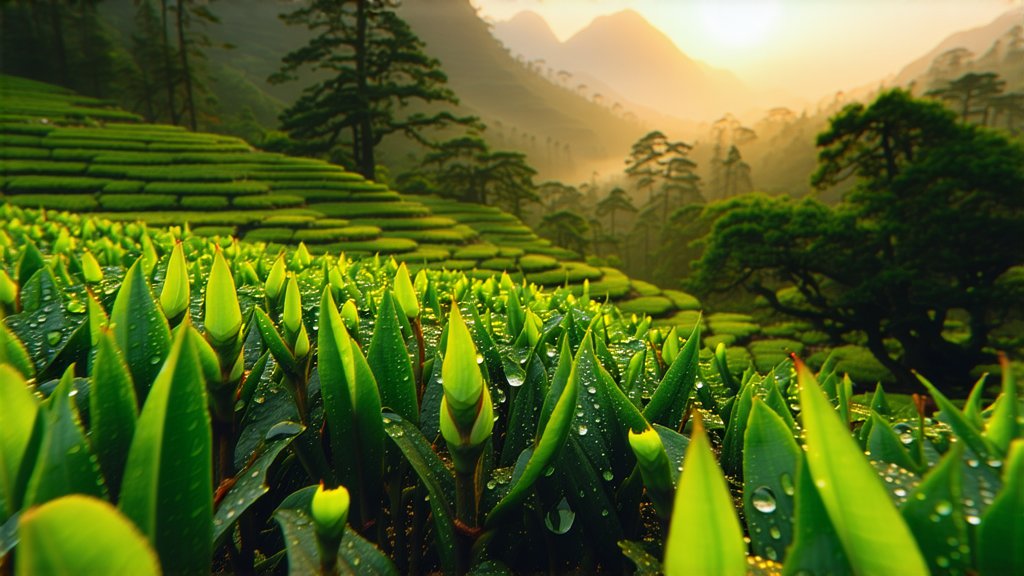
In the vast and diverse landscape of Chinese tea culture, where green, black, white, oolong, and pu-erh teas each hold their own unique place, there exists a lesser-known gem that glimmers like gold—Huoshan Yellow Buds. This exquisite variety of yellow tea, hailing from the verdant hills of Anhui province in eastern China, is not only a testament to the artistry of traditional tea making but also a symbol of the region's rich cultural heritage. In this exploration, we delve into the history, varieties, meticulous craftsmanship, and the nuanced art of appreciating Huoshan Yellow Buds, inviting global tea enthusiasts to discover its hidden charms.
A Glimpse into History
The tale of Huoshan Yellow Buds is intertwined with the ancient history of Chinese tea cultivation. While the exact origins of this tea remain shrouded in mystery, it is widely believed that its production techniques were developed during the Ming Dynasty (1368-1644), a period marked by significant advancements in agriculture and arts. Unlike more popular green teas, which are quickly fixed by firing or pan-frying to retain their green color, yellow tea undergoes a unique post-harvest process known as "men huang" or "sealing yellow," allowing it to partially oxidize and develop its distinctive golden hue and subtle flavors.
Varieties and Characteristics
Huoshan Yellow Buds stands out among other yellow teas due to its specific geographical indication, which encompasses the Huoshan and Jinzhai counties in Anhui. These areas boast ideal climatic conditions—mild temperatures, abundant rainfall, and fertile soil—that contribute to the tea's exceptional quality. The tea bushes used for Huoshan Yellow Buds are primarily of the Camellia sinensis var. sinensis species, known for producing delicate yet flavorful leaves.
The finished product showcases slender, downy buds interspersed with young leaves, resembling miniature tassels of gold. When brewed, the liquor reveals a pale yellow-green color, exuding a gentle aroma reminiscent of fresh hay and a hint of sweetness. Its taste profile is characterized by a smooth, mellow texture with notes of honey, chestnut, and a whisper of fruitiness, making it a soothing and contemplative beverage.
Crafting the Golden Elixir
The journey from leaf to cup for Huoshan Yellow Buds is a meticulous one, demanding precision and patience. Here's an overview of the traditional processing steps:
-
Plucking: Only the tenderest buds and top leaves are handpicked during the early spring, typically between March and April when the first flush of growth occurs. This ensures optimal flavor and nutritional content.
-
Withering: The freshly harvested leaves are spread out thinly on bamboo mats or trays under shade, allowing them to gradually lose moisture and become soft and pliable. This step can take several hours to a day, depending on weather conditions.
-
Fixation: Unlike green tea's immediate heat treatment, yellow tea undergoes a milder form of fixation. The withered leaves are gently stir-fried or steamed just enough to halt enzymatic activity without fully stopping oxidation.
-
Men Huang (Sealing Yellow): This is the defining stage where the magic happens. The partially fixed leaves are wrapped in paper or cloth and left to rest in a humid environment for anywhere between 20 to 48 hours. During this time, controlled oxidation takes place, turning the leaves a light yellow color and developing complex flavors.
-
Drying: Finally, the leaves are carefully dried using low heat to remove any remaining moisture, ensuring they retain their delicate flavors and aromas. This step completes the transformation into the sought-after Huoshan Yellow Buds.
The Art of Tasting
To truly appreciate Huoshan Yellow Buds, one must engage in the ritual of Gongfu Cha, a traditional Chinese tea ceremony that emphasizes mindfulness and sensory awareness. Here’s how to embark on this journey:
-
Preparation: Start with fresh, cold water and heat it to around 80-85°C (175-185°F). Use a Yixing clay teapot or a clear glass pot to observe the茶叶 unfolding gracefully.
-
Warming: Rinse the teapot and cups with hot water to warm them up and enhance the tea's aroma.
-
Infusion: Place approximately 3-5 grams of Huoshan Yellow Buds per 150ml of water ratio into the pot. Steep for about 1-2 minutes for the first infusion, adjusting subsequent steeps according to personal preference.
-
Observation: As the leaves unfurl, they create a mesmerizing dance, releasing their golden essence into the liquid. Notice the color transformation from pale yellow to a deeper amber with each brew.
-
Smelling & Sipping: Inhale deeply before taking your first sip to capture the tea's aromatic bouquet. Sip slowly, allowing the tea to coat your palate, and savor the intricate layers of flavor that evolve with each taste.
-
Reflection: Take a moment to reflect on the experience, noting how the tea's character evolves through multiple infusions, revealing new dimensions with each pour.
Conclusion
Huoshan Yellow Buds is more than just a tea; it embodies the harmony between man and nature, tradition and innovation. Its subtle elegance and depth make it a captivating subject for both seasoned tea connoisseurs and curious newcomers alike. By exploring its history, origins, understanding the intricate craftsmanship behind its production, and practicing the art of mindful tasting, one can unlock a world of sensory pleasures that transcend borders and cultures. So, let us raise our cups to this golden delicacy, celebrate its legacy, and invite others to join in the appreciation of this remarkable chapter in China's tea story.